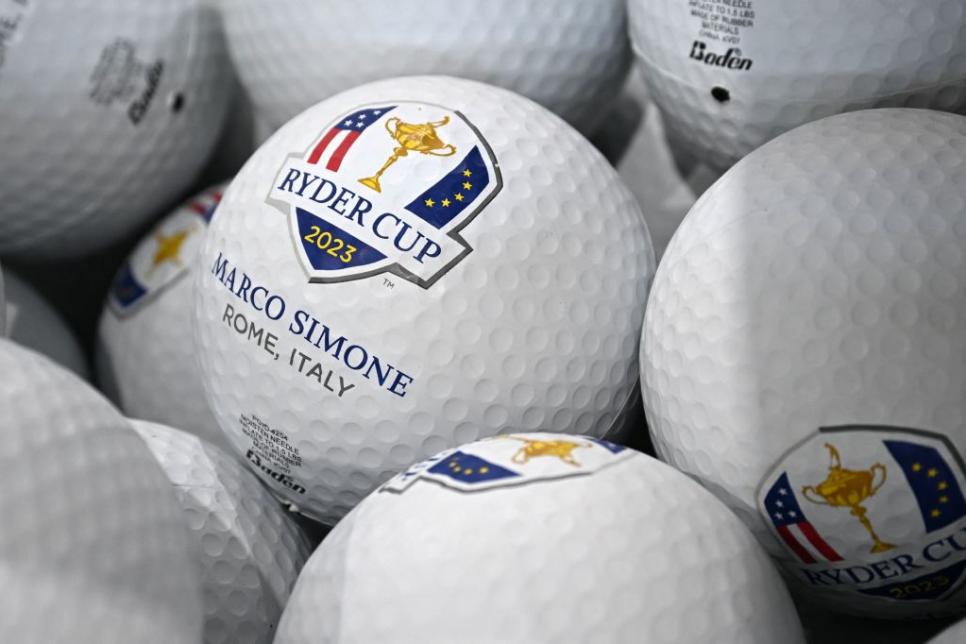[PHOTO: Jim Watson]
Golf has many different rules, but really only two different kinds of rules. Permanent rules, which exist for everyone everywhere, like that you’re only allowed 14 clubs in your bag. And local rules, which are specific rules for specific courses that don’t apply everywhere.
Let’s say your golf course has something unique, like a swimming pool in the middle of the sixth fairway. The course may say that you get a free drop if your hit your ball into the swimming pool. I don’t know why I chose that example, but nevertheless, that’d be an example of a local rule.
Anyway, the one-ball rule—which specifies that golfers are only allowed to use the same make and model of golf ball during their round—is technically a model local rule, which means tournaments can adopt it (or not) whenever they want. When that rule isn’t in play, players can change to whatever ball they want between holes, as much as they want.
Players, on the whole, don’t love the one-ball rule, so increasingly tournaments have stopped using it. The PGA Championship didn’t employ the one-ball rule earlier this year, which is why you saw Phil Mickelson play two different balls during one round.

During his press conference on Tuesday, U.S. Ryder Cup captain Zach Johnson dropped an interesting nugget.
“The one-ball rule is not in effect,” Johnson said, plainly.
This may sound like a boring technicality that doesn’t really matter, but it actually kind of does. I’d put it somewhere between a big deal and a huge deal.
Why? Because it means that during the crucial foursomes, alternate-shot sessions, players will be able to swap golf balls between holes. Previously, when the one-ball rule was in effect, each foursomes pairing would have to pick one ball at the start of the round and use it throughout. Historically, this has been an interesting ongoing subplot of the two sessions.
It was switching golf balls between holes that was the source of the famous Paul Azinger–Seve Ballesteros rules kerfuffle. It also provided some drama to the ill-fated Tiger Woods–Phil Mickelson pairing in 2004 (which Phil used Tiger’s golf ball after switching manufacturers in the final weeks leading up), and even at the most recent Ryder Cup, when Matt Fitzpatrick and Lee Westwood were paired together twice in foursomes despite playing different golf balls, and lost both their matches.
Going through @RyderCup course data to predict some foursome pairing strategy.
Not an exact science but looks like….
Player A (odd holes) probably needs to be better iron player, hitting twice as many approaches. Three of four par threes are odd holes.
Player B (even holes)… pic.twitter.com/krgxBYMzT5
— Jamie Kennedy (@jamierkennedy) September 25, 2023
If you’re wondering why this matters, it’s because pros are very particular about their golf balls because it’s the one piece of equipment they use on every shot. They dial-in their golf ball specs to exact degrees to maximise distance and control.
Now players will decide which golf ball to use on a hole-by-hole basis, rather than once at the start of the round. Johnson says he’s leaving the specifics up to each pairing to sort out themselves, but that generally they’ll go with the golf ball for the player who will hit the approach shot into the green.
“If we are playing together, I’m probably going to tee off with your golf ball more times than not so that we can have more control with your iron play or your wedge play or whatever it may be with your own golf ball. That’s kind of the unwritten rule,” Johnson said. “These guys know what they are doing. I don’t need to coach them on how to go about doing that.”
It’s a change that helps both sets of players, and brings a lot more strategy into play—especially considering three of Marco Simone’s four par 3s fall on odd-numbered holes, and the course has multiple driveable par 4s. The team that will benefit the most will be the one that navigates the strategy of it the best.
• • •
This article was originally published on golfdigest.com



